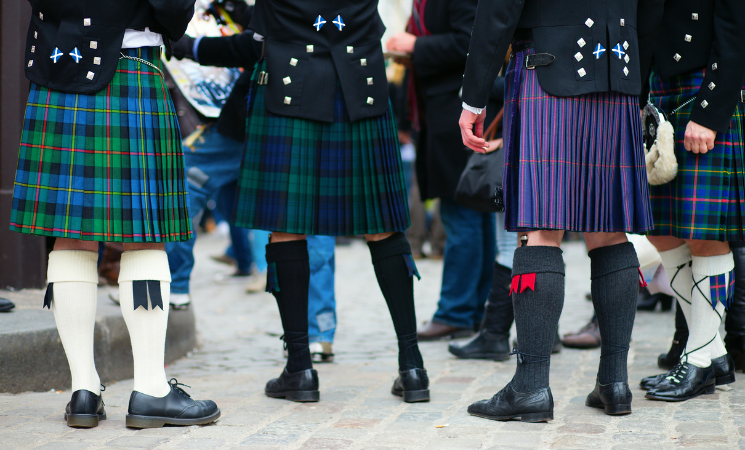Kilts – no, not the paint brand, but Scotland’s iconic garment! The first time I saw a kilt, I thought, “Is this Scotland’s version of a skirt?”. I thought, “What makes this patterned wool so special?” It wasn’t until I felt the thick, patterned wool that I realized this wasn’t just a piece of clothing – it was a masterpiece of practicality and culture.
Scotland’s weather might be famous for being unpredictable, but the kilt, as I learned, has been perfectly crafted to meet its challenges.
If you’ve ever heard someone describe Scotland’s weather, they probably used words like “unpredictable” or “moody.” And they’d be absolutely right. Here’s the truth:
Scotland’s climate is temperate and oceanic, meaning mild temperatures but a good dose of rain and wind throughout the year. Summers (June to August) rarely go above 66°F (19°C), while winters (December to February) sit around 30°F to 43°F (-1°C to 6°C). Autumn brings cooler days and stunning golden landscapes, and October, in particular, is known for its crisp air and frequent rain showers.
The weather can change in a heartbeat – you could start the day with clear skies and end it with mist rolling in from the hills.
What Are Kilts, and Why Do They Matter?
When you think of Scotland, what comes to mind? Bagpipes, haggis, and, of course, kilts. But let’s dive deeper – what is a kilt, really?
Kilts are knee-length garments made from tartan wool, a fabric woven with patterns that represent Scottish clans or families. But they’re so much more than a fashion statement:
Kilts are deeply tied to Scotland’s identity, often worn during weddings, Highland Games, and other cultural events. Historically, kilts weren’t just for show. The great kilt, a large piece of fabric, doubled as a cloak or blanket, making it indispensable for Highland life.
Today’s kilts have evolved, but they still honor their roots. They’re tailored and secured with straps or buckles and often paired with accessories like sporrans (pouches) and kilt hose (socks).
I didn’t realize until later how much thought went into designing a garment that could handle Scotland’s rugged terrain and unpredictable weather.
Here’s the surprising part: Kilts are not just ceremonial – they’re practical, especially in Scotland’s climate.
Imagine this: You’re hiking through the misty Scottish Highlands, the wind picking up speed. While others shiver in synthetic layers, your kilt keeps you warm and dry. Functional, right?
How Do Kilts Help with Scotland’s Weather?
You wouldn’t think of wool as summer-friendly, but kilts are made from tartan wool 1, which is breathable and keeps you cool on warmer days. The same wool is a natural insulator, trapping warmth to keep you comfortable in chilly weather.
Ever felt how wool repels light rain? That’s thanks to the lanolin in the fibers, which makes kilts ideal for Scotland’s drizzle-heavy days. The dense fabric acts as a shield against those brisk Highland winds, especially when you’re outdoors. Historically, the great kilt could be unwrapped and used as a blanket or even a shelter – a survival tool in rugged environments.
Here’s something I didn’t expect – kilts have traveled far beyond Scotland and are embraced in different ways around the world:
- Irish kilts, often made in solid colors like saffron or green, are tied to Irish cultural pride rather than specific clans. They are popular at Irish festivals and St. Patrick’s Day parades.2
- Scottish regiments in the British Army and even some Canadian military units continue to wear kilts as part of their ceremonial dress, honoring their Scottish heritage. 3
- Scottish communities worldwide, especially in countries like the United States, Canada, and Australia, wear kilts during cultural celebrations, like Highland Games or weddings.
- Designers and celebrities have reimagined kilts, bringing them into mainstream fashion. Think Harry Styles or Vin Diesel – yes, kilts have gone Hollywood! 4
What struck me most when learning about kilts is how they blend practicality with meaning. They’re not just clothes – they’re storytelling pieces. Each tartan pattern tells a story of a family, a region, or even a historic event.
Wearing a kilt isn’t just about braving the weather; it’s about connecting to Scotland’s past, where every Highlander owned a great kilt that doubled as both clothing and a tool for survival. It’s a garment with roots as deep as the lochs.
Scotland’s weather might be moody, but kilts are the steady constant. So next time you see a kilt, don’t just think of it as ceremonial – it’s a masterclass in blending tradition with utility. And if you ever visit Scotland, consider trying one. Who knows? You might just feel like you’re wearing a piece of history while staying cozy in the drizzle.













